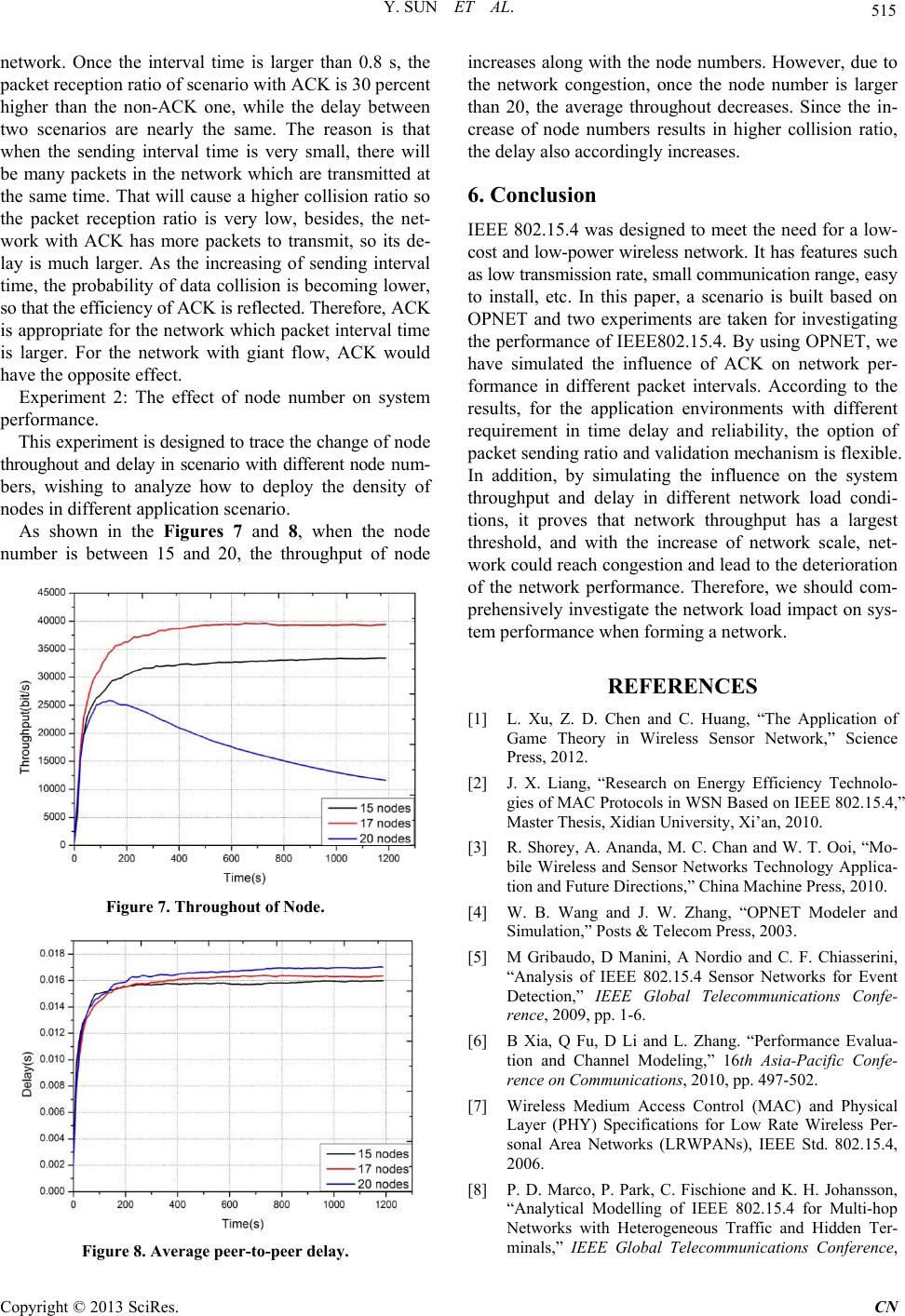
Y. SUN ET AL.
Copyright © 2013 SciRes. CN
network. Once the interval time is larger than 0.8 s, the
packet reception ratio of scenario with ACK is 30 percent
higher than the non-ACK one, while the delay between
two scenarios are nearly the same. The reason is that
when the sending interval time is very small, there will
be many packets in the network which are transmitted at
the same time. That will cause a higher collision ratio so
the packet reception ratio is very low, besides, the net-
work with ACK has more packets to transmit, so its de-
lay is much larger. As the increasing of sending interval
time, the probability of data collision is becoming lowe r,
so that the effic ien cy of ACK is reflected. Therefore, ACK
is appropriate for the network which packet interval time
is larger. For the network with giant flow, ACK would
have the opposite effect.
Experiment 2: The effect of node number on system
performance.
This experiment is designed to trace the change of node
throughout and delay in scenario with different node num-
bers, wishing to analyze how to deploy the density of
nodes in di fferent application scenario.
As shown in the Figures 7 and 8, when the node
number is between 15 and 20, the throughput of node
Figure 7. Throughout of Node.
Figure 8. Average peer-to-peer delay.
increases along with the node numbers. However, due to
the network congestion, once the node number is larger
than 20, the average throughout decreases. Since the in-
crease of node numbers results in higher collision ratio,
the delay also accordingly increases.
6. Conclusion
IEEE 802.15.4 was designed to meet the need for a low-
cost and low-power wireless network. It has features such
as low transmission rate, small communication range, easy
to install, etc. In this paper, a scenario is built based on
OPNET and two experiments are taken for investigating
the performance of IEEE802.15.4. By using OPNET, we
have simulated the influence of ACK on network per-
formance in different packet intervals. According to the
results, for the application environments with different
requirement in time delay and reliability, the option of
packet sending ratio and validation mechanism is flexible.
In addition, by simulating the influence on the system
throughput and delay in different network load condi-
tions, it proves that network throughput has a largest
threshold, and with the increase of network scale, net-
work could reach conges tion and lead to the deter ioration
of the network performance. Therefore, we should com-
prehensively investigate the network load impact on sys-
tem performance when forming a network.
REFERENCES
[1] L. Xu, Z. D. Chen and C. Huang, “The Application of
Game Theory in Wireless Sensor Network,” Science
Press, 2012.
[2] J. X. Liang, “Research on Energy Efficiency Technolo-
gies of MAC Protocols in WSN Based on IEEE 802.15.4,”
Master Thesis, Xidi an University, Xi’an, 2010.
[3] R. Shorey, A. Ananda, M. C. Chan and W. T. Ooi, “Mo-
bile Wireless and Sensor Networks Technology Applica-
tion and Future Directions,” China Machine Press, 2010.
[4] W. B. Wang and J. W. Zhang, “OPNET Modeler and
Simulation,” Posts & Telecom Press, 2003.
[5] M Gribaudo, D Manini, A Nordio and C. F. Chiasserini,
“Analysis of IEEE 802.15.4 Sensor Networks for Event
Detection,” IEEE Global Telecommunications Confe-
rence, 2009, pp. 1-6.
[6] B Xia, Q Fu, D Li and L. Zhang. “Performance Evalua-
tion and Channel Modeling,” 16th Asia-Pacific Confe-
rence on Communications, 2010, pp. 497-502.
[7] Wireless Medium Access Control (MAC) and Physical
Layer (PHY) Specifications for Low Rate Wireless Per-
sonal Area Networks (LRWPANs), IEEE Std. 802.15.4,
2006.
[8] P. D. Marco, P. Park, C. Fischione and K. H. Johansson,
“Analytical Modelling of IEEE 802.15.4 for Multi-hop
Networks with Heterogeneous Traffic and Hidden Ter-
minals,” IEEE Global Telecommunications Conference,